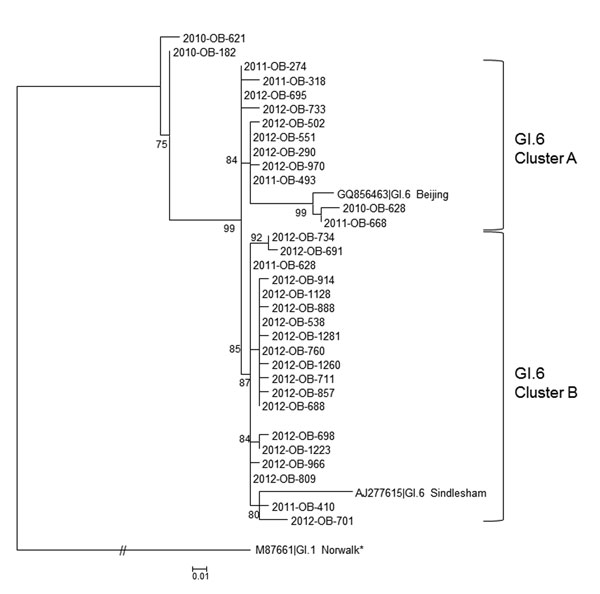Volume 19, Number 8—August 2013
Dispatch
Genotype GI.6 Norovirus, United States, 2010–2012
Figure 1

Figure 1. . Phylogenetic typing results for GI.6 noroviruses, United States, 2010–2012. Representative outbreak nucleotide sequences were genotyped by region D (5). Sequences were downloaded, trimmed, and analyzed as described (5). In brief, a 3-parameter model, TPM1, with equal frequencies and invariable sites was run in PhyML 3.0 (www.atgc-montpellier.fr/phyml/binaries.php) as determined by jModel test by using the corrected Akaike information criterion. The best of 5 random trees was used to start the analysis, and the approximate likelihood ratio test was used for branch support. GI.6 reference sequences (GenBank accession nos. GQ856463| GI.6 Beijing and AJ277615| GI.6 Sindlesham) were included. Two clusters of genetically related outbreaks (cluster A and cluster B) are marked by brackets. *The distance of GI.1 Norwalk to the nearest GI.6 cluster is 2.29 substitutions per site. Scale bar indicates nucleotide substitutions per site for the phylogenetic tree.
References
- Hall AJ, Eisenbart VG, Etingue AL, Gould LH, Lopman BA, Parashar UD. Epidemiology of foodborne norovirus outbreaks, United States, 2001–2008. Emerg Infect Dis. 2012;18:1566–73 and. DOIPubMedGoogle Scholar
- Hall AJ, Lopman BA, Patel MM, Gastañaduy PA, Vinjé J. Norovirus disease in the United States. Emerg Infect Dis. 2013;19: 1198–1205.DOIPubMedGoogle Scholar
- Hall AJ, Wikswo ME, Manikonda K, Roberts VA, Yoder JS, Gould LH. Acute gastroenteritis surveillance through the National Outbreak Reporting System, United States. Emerg Infect Dis. 2013;19: 1305–9.
- Bok K, Green KY. Norovirus gastroenteritis in immunocompromised patients. N Engl J Med. 2012;367:2126–32. DOIPubMedGoogle Scholar
- Vega E, Barclay L, Gregoricus N, Williams K, Lee D, Vinje J. Novel surveillance network for norovirus gastroenteritis outbreaks, United States. Emerg Infect Dis. 2011;17:1389–95 .PubMedGoogle Scholar
- Yen C, Wikswo ME, Lopman BA, Vinje J, Parashar UD, Hall AJ. Impact of an emergent norovirus variant in 2009 on norovirus outbreak activity in the United States. Clin Infect Dis. 2011;53:568–71. DOIPubMedGoogle Scholar
- Zheng DP, Widdowson MA, Glass RI, Vinje J. Molecular epidemiology of genogroup II-genotype 4 noroviruses in the United States between 1994 and 2006. J Clin Microbiol. 2010;48:168–77. DOIPubMedGoogle Scholar
- Leshem E, Wikswo ME, Barclay L, Salehi E, Storm W, Brandt E, Effects and clinical significance of GII.4 Sydney norovirus, United States, 2012–2013. Emerg Infect Dis. 2013;19:1231–8.
- Bruggink LD, Oluwatoyin O, Sameer R, Witlox KJ, Marshall JA. Molecular and epidemiological features of gastroenteritis outbreaks involving genogroup I norovirus in Victoria, Australia, 2002–2010. J Med Virol. 2012;84:1437–48. DOIPubMedGoogle Scholar
- Desai R, Hembree CD, Handel A, Matthews JE, Dickey BW, McDonald S, Severe outcomes are associated with genogroup 2 genotype 4 norovirus outbreaks: a systematic literature review. Clin Infect Dis. 2012;55:189–93. DOIPubMedGoogle Scholar
- Centers for Disease Control and Prevention. Updated norovirus outbreak management and disease prevention guidelines. MMWR Recomm Rep. 2011;60(RR-3):1–18 .PubMedGoogle Scholar